 "I sent the following message 'Please identify yourself.'
"I sent the following message 'Please identify yourself.'
Return message: 'German U-Boat 805.'
U-805 off Portsmouth.
That was it! That was the first U-Boat to come into the United States under its own power and voluntarily surrender. I had made a part of history. I went down below, recorded the number of the U-Boat and the time into the log book, picked up the phone, called the Duty Officer, identified myself and made the following report: 'Sir, we have challenged and identified the U-805.'
He thanked me and at no time did he express any amazement or surprise; said nothing like: 'Are you sure what you are saying?' That was it; he said nothing, thanked me and put the phone down.
I went topside and in a matter of minutes, two tugs came from around the bend in the lower harbor. The Duty Officer had to be alerted and the yard tugs, crews and Marines on board had to be on stand-by duty to get out into the channel that quickly. I'm directly at the stern of the 805. The second tug moved up and secured itself to the port side to the 805. From where I was watching, it seemed that the bridge of the tug and the conning tower of the 805 were even-steven.
Up the channel they came - when they got close enough, I whipped out my four-dollar BROWNIE camera and started taking pictures. I had no fear, nobody could see me and with the doors to the Signal Tower bolted from the inside, no officers, Master at Arms or Chief would catch me taking these pictures.
When they disappeared around the bend into the lower harbor, that was the end of the 805 saga. Consequently, I learned that the 805 had tied up to one of our big buoys in the lower harbor where she would be kept for 48 hours in case the German Captain or crew decided to plant demolition charges, they would have been in for a big surprise! No one on that boat could have reached shore, the current of the river coming down through through the submarine base down the channel would have swept every man to his death. There would have been no survivors.
I have in my possession, a copy of the letter from Atlantic Fleet Headquarters, indicating that if a German Captain or crew scuttled their boat, there would be no survivors. There would be no rescue attempt; any and all crew would go down with the boat. So ended the first drama of the War's end.
 U-234 coming into Portsmouth.
U-234 coming into Portsmouth.
The next thing we had was one rumor after another sweeping the sub base. We had captured a German submarine on the high seas identified as the U-234. The USS SUTTON, USS SCOTT and two Canadian frigates have been directed to the 234's position. The 234 had then been ordered to Maine, but due to inclement weather, high seas, fog and icebergs, the Atlantic Fleet Headquarters had ordered SUTTON to divert 234 to Portsmouth.
The SUTTON indicated to Atlantic Fleet Headquarters that the 234 was a German transport submarine. Her cargo hatches were loaded with military equipment and supplies of all kinds, that there was a German General aboard by the name of Kessler, there were two Japanese officers who had killed themselves and subsequently had been thrown overboard.
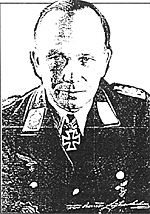
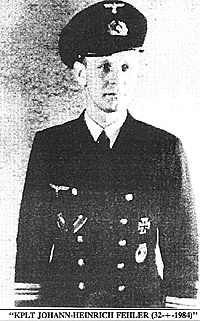 Left: U-234's Kplt. Johann-Heinrich Fehler (32-+-1984).
Right: General der Flieger Ulrich Kessler.
Left: U-234's Kplt. Johann-Heinrich Fehler (32-+-1984).
Right: General der Flieger Ulrich Kessler.
(HARRY'S NOTE - General Ulrich Kessler was the new Chief of the Luftwaffe, after orders were given to COL SS BERNHARD FRANK (3225-1993) to arrest and execute Hermann Goring. The two Japanese officers were not 'thrown overboard' but were given normal military burials at sea by the crew of U-234 before they surrendered to USS SUTTON.)
Rumor was the two Japanese officers ended up in the bilges. CAPTAIN FEHLER (32-+-1984), Commanding Officer of the U-234 indicated to HARRY COOPER (1-LIFE-1983) that at no time did the Japanese end up in the bilges but were buried at sea.
One day, nothing. The next morning, there is the U-234 in a flooded drydock. In the interim, the yard dock had mounted a six-foot green canvas shield on the retaining wall, effectively sealing off the drydock. Anyone attempting to reach the drydock would simply be pushed away: 'Move along, Sailor. This is a RESTRICTED AREA.' Anybody walking by the area merely had to turn his head left and right; there was the conning tower of the U-234 clearly visible.
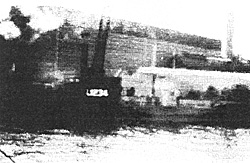 "U-234 shot by JIM's $4 BROWNIE"
"U-234 shot by JIM's $4 BROWNIE"
During my early arrival at Portsmouth, I met three people. One was a former Division Officer when I had been stationed at Destroyer Base, San Diego in early 1942. The second was a Marine from my hometown, who was doing guard duty at the Portsmouth Naval Prison, who was a former member Marine Division and a Guadalcanal veteran. The third individual was a sailor from my hometown, Walsh. Recall the name Walsh because he will now become a very important person.
The morning after U-234 had been pulled into the drydock, I met Walsh at breakfast. He told me that he had been assigned to the U-234 on an all-day basis. He would simply baby-sit her and allow no one else on board. He wanted to know if I wanted to get on board and I said: 'Fine, what will I have to do?'
He said: 'Between 1300 and 1400 hours, get ahold of a web cartridge belt, make it look like you are going on watch. Walk up the gangplank and tell the Marine I was a relief.'
While one of them held me at the foot of the catwalk, the second Marine went up the catwalk on to the deck of the 234, talked to Walsh, turned around and pointed to me. He talked some more and pretty soon he came back down and said: 'Okay, he says you're his relief. Go ahead.'
I walked up the narrow catwalk, stepped onto the deck of the U-234. Walsh and I talked for a few minutes, then we went down below. Walsh wanted to know if I wanted to take a COOKES TOUR of 234 and I agreed.
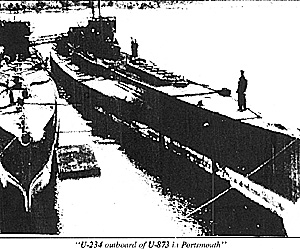 U-234 outboard of U-873 in Portsmouth.
U-234 outboard of U-873 in Portsmouth.
Now all these years later, there are some things that stand out in my mind.....the engine room. The engine room was well lighted, there were the twin diesels hooked up in tandem, port and starboard. The steel deck plates were covered with a film of oil which made it very slippery, and I wondered when the sub was under way in high seas, what was to prevent some poor bastard from bouncing from one engine to the other. I could hardly stand up walking while the sub was stationery.
Another thing that I noticed was that the bulkheads of the U-234 were painted black. It was dark and dreary, and it was very, very uncomfortable. From the overhead, there was a light cord with a socket and a light bulb attached. The light bulb was a very small one, it was no more than 40 watts. I can't recall if the light was on or off. All I know was that compartment was dark.
I noted to Walsh that the bunks had wooden frames no doubt in an effort to save steel. At no time in the interior of U-234 did I see cartons, crates or boxes. I didn't see any gold bullion; I didn't see any silver bullion; I didn't see any works of art; I didn't see any German currency - NOTHING.
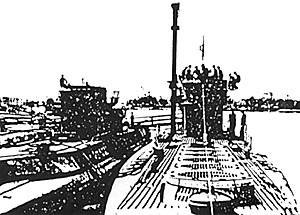 Bows on view of U-234 alongside U-873.
Bows on view of U-234 alongside U-873.
The cargo hatches were loaded. According to the SUTTON, the U-234 also had retained a large amount of ammunition and had 7 torpedoes on board. Prior to leaving Germany for Christiansand Norway, German workmen had cut holes into the keel of U-234, using the open space for additional storage. The keel was then re-sealed. The sub left Germany, arriving at Christiansand and the small fishing village at the southern tip of Norway for more passengers and cargo, and departed the North Atlantic for the trip to Japan. The War ended - the rest is history.
We now talk about the number of submarines that we had at Portsmouth; I believe the number was some ten or eleven. At least five of them were conventional - they were just subs. You seen one, you've seen them all; then there was U-234.
We also had some TYPE XXI boats. These were outstanding design subs; ten, fifteen even twenty years ahead of anything we had in the American Navy. The subs had no deck gun, had no chains, no guard rails, no net cutter, no strung our aerials. The sail was about 25 feet in height and the tower was diamond shaped, very narrow. The schnorkel and the attack scopes had retracted into the well of the conning tower so they were not visible.
The odd thing about these boats is that they were painted a color I had never seen before. Not on any warship, not on any submarine. It was either a tan color, yellow color, or a light brown color. Perhaps these were primer paints. Perhaps the German dock crew did not have time to complete the painting jobs. Well, with the Russians running down the Baltic, it appears that the Kriegsmarine decided to move these valuable boats out before the Russians arrived.
Every sailor who walked into Ships's Services and looked out the window could see the four boats. There were German crews aboard, and from time to time in the conning tower, you could see a white hat indicating that the Captain was aboard. There were no guards at the gangplanks, but I never saw an American sailor or an American officer on board the four boats.
From time to time going into Ship's Services, I noticed German enlisted personnel. They would be seated at tables with American sailors and conversation would always be in English. On one occasion, I sat at a table with two American sailors and were joined by a German sailor. The talk was general- how long would he be a P.O.W.; when would he go home; where was his family; was his family safe; was he in the east; was he in the west? At our table there was no discussion of the War, how many patrols he made, how many ships they sank. The War was over and I'm sure that everyone had had enough.
I still wonder at these boats. I never saw them leave Portsmouth. I know they were never tried out while I was there. Every submarine sailor said the same thing - when are we going to get our hands on these boats? When are we going to see what they can do surfaced and what can they do submerged? How far down will they go? They were beautifully designed boats, years ahead of anything that we had and certainly in all appearances, outstanding.
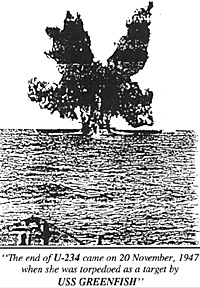 The end of U-234 came on 20 November, 1947 when she was torpedoed as a target by USS GREENFISH.
The end of U-234 came on 20 November, 1947 when she was torpedoed as a target by USS GREENFISH.
Some of the items on board U-234 include plans and drawings of the Me 262 Messerschmitt jet fighter.
(HARRY'S NOTE - there were two complete jet aircraft on board, in crates, ready to be re-assembled in Japan to be used as prototypes for Japan to begin building them in quantity). There were also plans and drawing of the JUNKERS tri-motor aircraft, there was lead, zinc, mercury, steel, fuses for anti-aircraft ammunition, anti-tank ammunition, optical instruments, classified documents for the Japanese Army and Navy, classified documents for the German Embassy.
I want to make special mention covering one item of U-234. Above and beyond the items that were listed, the U-234 on the way to Japan had in her cargo hatches, ten cases (weight 560 kilos) URANIUM OXIDE consigned to the Japanese Army! Apparently, the Germans and the Japanese, in a desperate attempt, were still trying to make the atomic bomb.
More: The Way It Was: US Navy
Back to KTB #107 Table of Contents
Back to KTB List of Issues
Back to MagWeb Master Magazine List
© Copyright 1994 by Harry Cooper, Sharkhunters International, Inc.
This article appears in MagWeb (Magazine Web) on the Internet World Wide Web. Other military history articles articles are available at http://www.magweb.com
Join Sharkhunters International, Inc.: PO Box 1539, Hernando, FL 34442, ph: 352-637-2917, fax: 352-637-6289, www.sharkhunters.com
